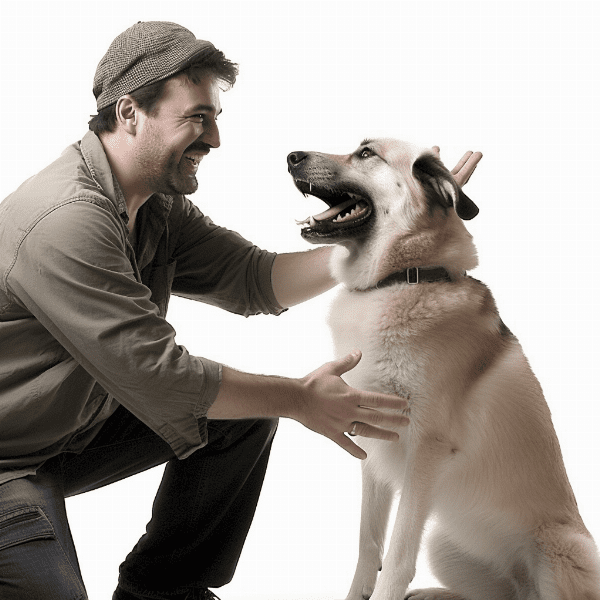Table of Contents
- Understanding Rottweiler Aggression: Causes and Types
- Signs of Aggression in Rottweilers: How to Recognize Them
- Safety Precautions when Dealing with Aggressive Rottweilers
- Training Techniques to Control Rottweiler Aggression
- How to Socialize a Rottweiler: Preventing Aggression from an Early Age
- Common Mistakes to Avoid when Dealing with Aggressive Rottweilers
- Seeking Professional Help: When to Consult a Dog Behaviorist
- Legal and Ethical Considerations when Owning an Aggressive Rottweiler
- Alternative Options for Dealing with Aggressive Rottweilers
- Living with an Aggressive Rottweiler: Coping Strategies for Pet Owners.
Understanding Rottweiler Aggression: Causes and Types
Rottweilers are powerful and confident dogs that are naturally protective of their families. However, when they perceive a threat or feel insecure, they can become aggressive. It is important to understand the different types and causes of aggression in Rottweilers to effectively prevent and manage it.
Nature vs. Nurture: Genetic and Environmental Factors
Aggression in Rottweilers can be influenced by both genetic and environmental factors. Some Rottweilers are naturally more aggressive than others due to their breeding or lineage. On the other hand, aggression can also be a result of poor socialization, neglect, abuse, or traumatic experiences.
Territorial Aggression: Protecting their Domain
Rottweilers are known to be territorial and protective of their homes and families. This type of aggression can be triggered by the presence of strangers, other dogs, or even unfamiliar objects in their territory. Territorial aggression can also occur when Rottweilers are confined or tied up, making them feel trapped and vulnerable.
Fear Aggression: Responding to Perceived Threats
Fear aggression is a common type of aggression in Rottweilers. This occurs when a dog perceives a threat and reacts with aggression to defend themselves. Fearful Rottweilers may become aggressive when they encounter unfamiliar people, animals, or situations that they perceive as dangerous.
Dominance Aggression: Establishing Hierarchy
Rottweilers are pack animals and are hard-wired to establish dominance hierarchies. Dominance aggression can occur when Rottweilers perceive themselves as the leader of the pack and feel the need to assert their dominance over other dogs or people. This type of aggression can also occur when Rottweilers feel threatened or challenged by other dogs or people.
Redirected Aggression: Misdirected Anger
Redirected aggression occurs when a Rottweiler is unable to act on their aggression towards the perceived threat and instead redirects their anger towards a more accessible target, such as a person or another dog. This type of aggression can occur when Rottweilers are restrained or confined and unable to respond to the source of their aggression.
Understanding the causes and types of aggression in Rottweilers is crucial in developing effective strategies to prevent and manage it. By addressing the root cause of the aggression, pet owners can provide a safe and secure environment for their Rottweilers while also keeping their families and other pets safe.
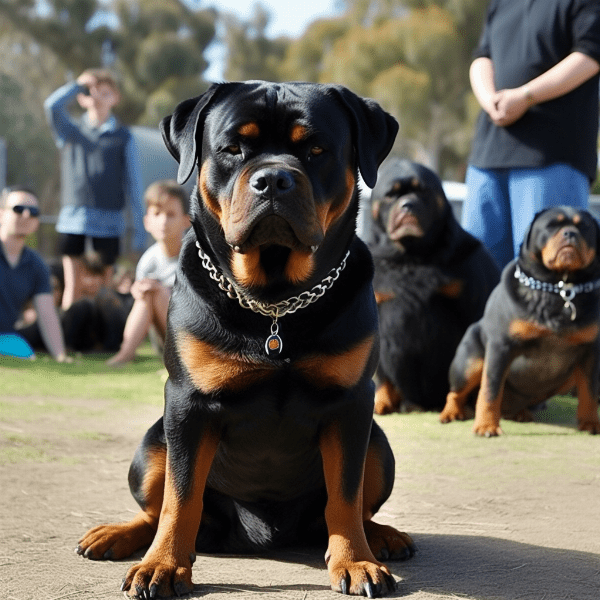
Signs of Aggression in Rottweilers: How to Recognize Them
It is essential to be able to recognize the signs of aggression in Rottweilers to prevent potentially dangerous situations. While Rottweilers are generally loyal and protective dogs, their aggression can quickly escalate if not managed properly. Here are some common signs of aggression in Rottweilers to watch out for:
Body Language
Rottweilers display several body language cues that indicate their mood and level of aggression. These include:
- Stiff body posture
- Raised hackles
- Growling or snarling
- Bared teeth
- Raised tail or a stiff wagging tail
- Direct eye contact or a fixed stare
If you observe any of these signs, it is essential to take immediate action to avoid any potential danger.
Vocalizations
Rottweilers may use vocalizations to express their aggression. They may growl, snarl, bark, or even howl to show their displeasure or warn of an impending attack. It is crucial to recognize these vocalizations and respond accordingly to prevent the situation from escalating.
Aggressive Actions
Rottweilers can display various aggressive actions, including:
- Lunging or charging at people or animals
- Biting or snapping at people or animals
- Chasing or cornering people or animals
These aggressive actions can be triggered by a variety of factors, including fear, territoriality, and dominance.
Pre-Attack Behavior
Rottweilers may exhibit specific pre-attack behaviors that signal an imminent attack. These include:
- Freezing in place
- Staring intently
- Licking their lips or yawning
- Lowering their head
- Raising their paw
If you observe any of these pre-attack behaviors, it is essential to remove yourself and others from the situation immediately.
Recognizing the signs of aggression in Rottweilers is crucial to preventing dangerous situations. Pet owners should learn to identify these signs and take appropriate action to prevent their Rottweilers from escalating to aggression. Seeking professional help from a dog behaviorist may also be necessary to address any underlying issues causing the aggression.

Safety Precautions when Dealing with Aggressive Rottweilers
Dealing with an aggressive Rottweiler can be a challenging and potentially dangerous situation. It is essential to take proper safety precautions to prevent harm to yourself and others. Here are some safety precautions to follow when dealing with an aggressive Rottweiler:
Approach with Caution
Approach an aggressive Rottweiler with caution, and do not attempt to make physical contact without ensuring your safety. Stay at a safe distance and observe their behavior before attempting to interact with them.
Use Protective Gear
When dealing with an aggressive Rottweiler, it is crucial to use protective gear to prevent injury. Wear thick, long-sleeved clothing and gloves to protect yourself from bites and scratches. A face shield or helmet can also provide added protection.
Use a Leash and Muzzle
Always use a leash and muzzle when interacting with an aggressive Rottweiler. This will prevent them from biting or attacking and give you better control over the situation. Be sure to use a sturdy leash and properly fitted muzzle to ensure maximum safety.
Avoid Eye Contact
Avoid direct eye contact with an aggressive Rottweiler, as this can be seen as a challenge or threat. Instead, avert your gaze and remain calm and composed to avoid provoking them.
Do Not Punish or Yell
.
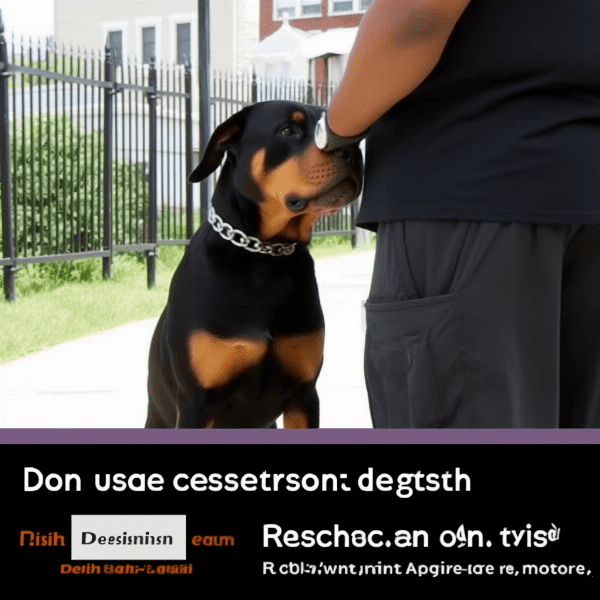
Training Techniques to Control Rottweiler Aggression
Training is an essential aspect of managing Rottweiler aggression. Proper training techniques can help prevent aggressive behavior and promote positive interactions with people and other animals. Here are some training techniques to control Rottweiler aggression:
Positive Reinforcement
Positive reinforcement techniques, such as reward-based training, can help encourage good behavior and discourage aggression in Rottweilers. Rewarding desirable behavior with treats, toys, or praise can help them learn to associate good behavior with positive outcomes.
Desensitization
Desensitization is a technique that can be used to reduce a Rottweiler’s sensitivity to certain triggers that may cause aggression. By gradually exposing them to the trigger in a controlled and safe environment, they can learn to tolerate it without reacting aggressively.
Counterconditioning
Counterconditioning involves teaching a Rottweiler to associate a positive response with a previously negative trigger. For example, if a Rottweiler displays aggression towards other dogs, counterconditioning can involve rewarding them for calm behavior in the presence of other dogs.
Obedience Training
Obedience training is a fundamental part of managing Rottweiler aggression. Teaching basic commands, such as “sit,” “stay,” and “come,” can help establish a clear hierarchy and promote better behavior. Obedience training can also provide mental stimulation and reduce boredom, which can help prevent aggression.
Socialization
Socialization is the process of exposing a Rottweiler to a variety of people, animals, and situations to help them become more comfortable and less reactive. Socialization should begin at a young age and involve positive interactions with other dogs and people.
Exercise and Play
Regular exercise and play can help reduce stress and prevent boredom in Rottweilers, which can contribute to aggression. Providing ample opportunities for exercise and play can also help promote a healthier and happier Rottweiler.
Using these training techniques can help control Rottweiler aggression and promote a positive and safe environment for both you and your pet. Seeking the help of a professional dog trainer or behaviorist may also be necessary to address any underlying issues causing the aggression.

How to Socialize a Rottweiler: Preventing Aggression from an Early Age
Socialization is a critical aspect of preventing aggression in Rottweilers. Proper socialization can help them become more comfortable around people and other animals, reducing their likelihood of displaying aggressive behavior. Here are some tips for socializing a Rottweiler from an early age:
Start Early
Socialization should begin as early as possible, ideally when a Rottweiler is between 3 and 12 weeks old. During this time, they are most receptive to new experiences and less likely to display fear or aggression.
Introduce New Experiences Gradually
Introduce new experiences, such as meeting new people and animals, gradually and in a controlled environment. Start with low-stress situations and gradually increase the level of complexity and challenge.
Use Positive Reinforcement
Use positive reinforcement techniques, such as treats, praise, and toys, to reward your Rottweiler for good behavior during socialization. This can help them associate positive experiences with socialization and reduce their likelihood of displaying aggression.
Expose Them to a Variety of Situations
Expose your Rottweiler to a variety of situations, including different people, animals, and environments. This can help them become more comfortable and confident in different settings, reducing their likelihood of displaying fear or aggression.
Supervise Interactions
Supervise all interactions between your Rottweiler and other people or animals. This can help prevent aggressive behavior and ensure that all interactions are positive and safe.
Seek Professional Help
If your Rottweiler displays fear or aggression towards people or other animals during socialization, seek the help of a professional dog trainer or behaviorist. They can help address any underlying issues causing the aggression and develop an effective socialization plan.
Socializing a Rottweiler from an early age can help prevent aggression and promote a positive and safe environment for both you and your pet. By following these tips, you can help your Rottweiler become a well-socialized and well-behaved member of the family.
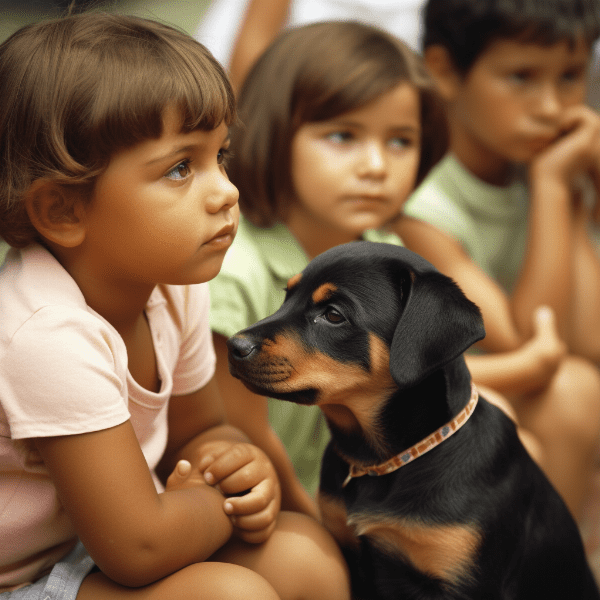
Common Mistakes to Avoid when Dealing with Aggressive Rottweilers
Dealing with an aggressive Rottweiler can be challenging, and it is essential to avoid common mistakes that can make the situation worse. Here are some common mistakes to avoid when dealing with aggressive Rottweilers:
Punishing Aggressive Behavior
Punishing aggressive behavior can make the situation worse and reinforce negative behaviors. Instead, focus on positive reinforcement techniques to encourage good behavior and address the underlying causes of their aggression.
Ignoring the Problem
Ignoring the problem and hoping it will go away on its own is not an effective way to deal with aggression in Rottweilers. Aggression can escalate quickly and become dangerous, and it is essential to address the issue as soon as possible.
Using Physical Force
Using physical force, such as hitting or kicking an aggressive Rottweiler, can make the situation worse and may result in injury. Physical force can also damage the relationship between you and your pet and lead to more aggressive behavior.
Failing to Socialize
Failing to socialize a Rottweiler can contribute to fear and aggression towards people and other animals. Socialization is a critical aspect of preventing aggression and promoting positive interactions.
Neglecting Exercise and Play
Neglecting exercise and play can contribute to boredom and stress, which can increase the likelihood of aggressive behavior in Rottweilers. Providing ample opportunities for exercise and play can help reduce stress and promote a healthier and happier pet.
Failing to Seek Professional Help
Aggression in Rottweilers can be a complex issue that may require the help of a professional dog trainer or behaviorist. Failing to seek professional help can lead to ineffective solutions and potentially dangerous situations.
Avoiding these common mistakes when dealing with an aggressive Rottweiler can help prevent the situation from escalating and promote a safe and positive environment for both you and your pet. By using positive reinforcement techniques, socializing your pet, and seeking professional help when necessary, you can effectively manage aggression in Rottweilers.

Seeking Professional Help: When to Consult a Dog Behaviorist
Dealing with aggression in Rottweilers can be a complex issue that may require the help of a professional dog behaviorist. Here are some situations when it may be necessary to consult a dog behaviorist:
Aggression Towards People
If your Rottweiler displays aggression towards people, such as growling, snarling, or biting, it is crucial to seek professional help. Aggression towards people can be dangerous and may require intensive training and behavior modification techniques.
Aggression Towards Other Animals
Aggression towards other animals, such as other dogs or cats, can also be a serious issue. A dog behaviorist can help address the underlying causes of the aggression and develop a training plan to reduce aggressive behavior towards other animals.
Escalating Aggression
If your Rottweiler’s aggression is escalating or becoming more frequent, it is essential to seek professional help. This can help prevent the situation from becoming more dangerous and promote a safe and positive environment for both you and your pet.
Fear-Based Aggression
Fear-based aggression can be challenging to address and may require the help of a professional dog behaviorist. A behaviorist can help your Rottweiler become more comfortable and confident in different situations, reducing their fear and aggression.
Underlying Health Issues
Underlying health issues, such as pain or discomfort, can contribute to aggression in Rottweilers. A dog behaviorist can help identify any underlying health issues and develop a treatment plan to address them.
Ineffective Training Techniques
If your current training techniques are not working, it may be necessary to seek the help of a professional dog behaviorist. They can help identify the underlying causes of your Rottweiler’s aggression and develop an effective training plan to promote positive behavior.
Seeking the help of a professional dog behaviorist can be a crucial step in managing aggression in Rottweilers. By addressing the underlying causes of aggression and developing an effective training plan, a behaviorist can help promote a safe and positive environment for both you and your pet.

Legal and Ethical Considerations when Owning an Aggressive Rottweiler
Owning an aggressive Rottweiler comes with legal and ethical responsibilities. It is essential to be aware of these considerations and take proper measures to promote safety and prevent harm. Here are some legal and ethical considerations when owning an aggressive Rottweiler:
Breed-Specific Legislation
Some areas may have breed-specific legislation that restricts or bans the ownership of certain breeds, including Rottweilers. It is essential to be aware of the laws in your area and comply with any regulations regarding Rottweiler ownership.
Liability and Insurance
Owning an aggressive Rottweiler can increase your liability and insurance premiums. It is important to have adequate liability insurance to protect yourself and others in case of an incident involving your Rottweiler.
Proper Containment
Proper containment, such as a sturdy fence or kennel, is necessary when owning an aggressive Rottweiler. This can help prevent your pet from escaping and potentially causing harm to others.
Public Safety
Public safety should be a top priority when owning an aggressive Rottweiler. It is important to keep your pet under control and avoid situations where they may pose a threat to others.
Ethical Considerations
Owning an aggressive Rottweiler comes with ethical considerations, including the welfare of your pet and the safety of others. It is important to provide proper care and training for your pet and to prioritize public safety and the safety of others.
Professional Help
Seeking the help of a professional dog trainer or behaviorist is an ethical responsibility when owning an aggressive Rottweiler. It is important to address the underlying causes of aggression and take proper measures to manage it effectively.
By being aware of these legal and ethical considerations when owning an aggressive Rottweiler, you can promote safety and prevent harm to yourself and others. Seek professional help, prioritize public safety, and provide proper care and containment for your pet to promote a safe and positive environment for both you and your Rottweiler.
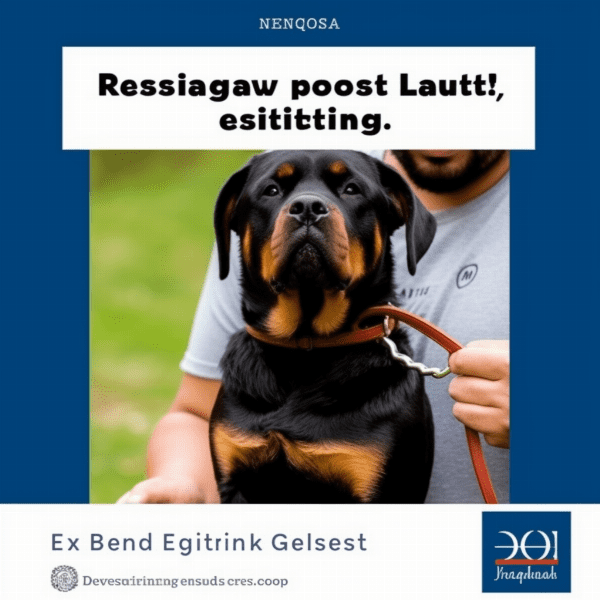
Alternative Options for Dealing with Aggressive Rottweilers
Dealing with aggression in Rottweilers can be a challenging and complex issue. If traditional training and behavior modification techniques are not effective, there are alternative options to consider. Here are some alternative options for dealing with aggressive Rottweilers:
Medication
Medication may be necessary to manage aggression in Rottweilers, especially if the aggression is related to anxiety or other underlying medical issues. Consult with a veterinarian or behaviorist to determine if medication is a viable option.
Alternative Therapies
Alternative therapies, such as acupuncture, massage, or aromatherapy, may also be helpful in managing aggression in Rottweilers. These therapies can help reduce stress and promote relaxation, which can contribute to more positive behavior.
Treadmill Training
Treadmill training can provide a safe and controlled environment for exercise and can be an effective way to manage aggression in Rottweilers. Treadmill training can help reduce stress and boredom, which can contribute to aggression.
Rehoming
Rehoming may be a viable option if traditional training and behavior modification techniques are not effective, and the aggression poses a significant threat to public safety. Rehoming should be done with the help of a professional and should prioritize the welfare of the Rottweiler.
Euthanasia
Euthanasia may be considered in extreme cases where the aggression poses a severe threat to public safety, and other options have been exhausted. Euthanasia should be a last resort and should only be considered after all other options have been explored.
When dealing with aggression in Rottweilers, it is essential to consider all options and prioritize public safety and the welfare of the pet. Consult with a veterinarian or behaviorist to explore alternative options and develop an effective management plan.

Living with an Aggressive Rottweiler: Coping Strategies for Pet Owners.
Living with an aggressive Rottweiler can be a challenging and stressful experience for pet owners. Here are some coping strategies to help manage the situation:
Educate Yourself
Educate yourself on Rottweiler behavior and aggression to better understand your pet’s behavior and how to manage it effectively. Consult with a veterinarian or behaviorist to learn about effective training and behavior modification techniques.
Stay Calm
Staying calm and composed during interactions with your Rottweiler can help prevent the situation from escalating. Avoid yelling or physical punishment and focus on positive reinforcement techniques.
Keep a Safe Distance
Keeping a safe distance from your Rottweiler can help prevent aggressive behavior and promote safety. Avoid situations that may trigger aggression and use proper containment, such as a sturdy fence or kennel.
Seek Support
Dealing with an aggressive Rottweiler can be emotionally draining, and it is essential to seek support from friends, family, or a professional counselor. They can provide a listening ear and offer guidance and support.
Practice Self-Care
Taking care of yourself is essential when living with an aggressive Rottweiler. Practice self-care techniques, such as exercise, meditation, or hobbies, to help reduce stress and promote overall well-being.
Consider Alternative Options
Consider alternative options, such as medication or alternative therapies, to help manage aggression in your Rottweiler. Consult with a veterinarian or behaviorist to determine if these options are appropriate.
Living with an aggressive Rottweiler can be challenging, but with proper education, management, and self-care, it is possible to manage the situation effectively. By staying calm, seeking support, and exploring alternative options, you can provide a safe and positive environment for both you and your pet.




